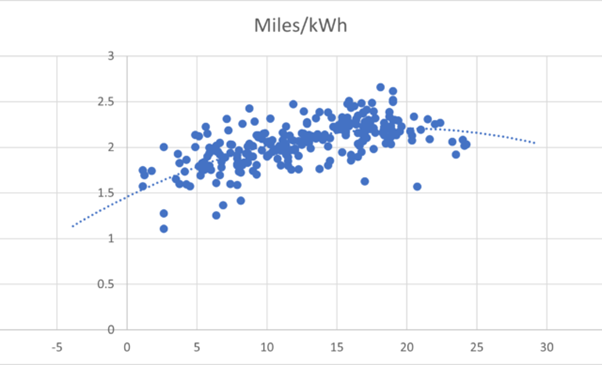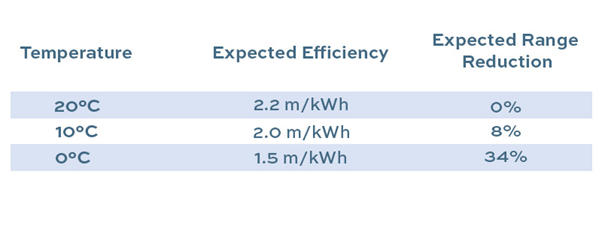How do you manage EV performance in a heat wave?
At optimal temperatures, electric fleet vehicles can achieve close to their predicted range. However, different extremes of temperature have a significant impact on how efficient an electric vehicle’s (EV’s) battery will be. For this reason, the effects of temperature can impact the efficiency of an entire fleet, making it difficult for you as a fleet manager to plan ahead. With temperatures in the UK expected to reach 40°C in some parts during the summer months and mini heatwaves predicted throughout May and June 2023, we explore how temperatures can affect the performance of electric fleets and provide tips on how your fleet can conserve energy during various weather conditions.
How do hot temperatures impact an EV fleet?
Although many expect cold weather to impact EV batteries, hot weather also plays a part in reducing the efficiency of e-LCVs. When temperatures rise above 25°C, the efficiency of the battery begins to degrade, with more reactions able to happen quicker – deteriorating a battery faster. The coolant system within the battery will also draw energy in order to keep the battery cool in warmer weather, again impacting range. To keep cool, drivers will turn on the air conditioning and, similar to diesel fleet vehicles, this impacts the range of an electric vehicle as it takes energy from the battery. But, it isn’t just during the journey, heat also impacts the efficiency during the charge, making the components of the charger less efficient in extreme heat.
Does ambient temperature affect my fleet performance?
EV fleet batteries are designed to work at an “optimal temperature” – typically around 20°C. With colder or warmer temperatures, the battery management systems need to ensure the battery remains at this optimal temperature. In addition, when outside temperatures begin impacting the conditions inside a fleet vehicle, such as using air-con or heating, this can cause the battery to be less efficient. Your fleet drivers will need to regulate the inside temperature of their LCVs in extreme weather. This consumes energy directly from the battery, reducing the range and efficiency. There are also the effects of temperature on the chemical reaction in the battery, which slows down the transfer of energy in colder weather. The combination of all of these effects could see a reduction in range of up to 35%
How to preserve energy during different weather conditions
All varying weather conditions can impact your fleet’s battery performance, due to drag and increased energy usage. Similar to hot and cold weather, rain and wind also impact vehicle efficiency. To help you educate your fleet drivers, we’ve included some tips on how to get the most from a fleet’s battery performance across different weather conditions:
Precondition your vehicle
Before a fleet vehicle sets off on its chosen journey, it’s advised to precondition the vehicle while it is still charging. This will allow the battery and the cabin to reach an optimal temperature without draining energy from the battery. If space permits, keep your fleet vehicles parked in a temperature-controlled garage, or a shaded area, to get a similar effect. This also helps preconditioning the battery to the optimal temperature.
Keep your vehicle plugged in
It is recommended that on extremely hot or freezing days to keep fleet vehicles plugged in when not in use. This allows the internal system to maintain battery temperature, prolonging the life of the battery before a vehicle leaves the depot or yard. Also, when considering charging infrastructure, position your business’s charging points in shady areas, hidden from direct sunlight.
Use Regenerative braking
Most EVs come fitted with regenerative braking, where the vehicle uses the electric motor to store energy lost in deceleration. If it’s safe to do so, anticipate braking and slow down by easing off the accelerator. This allows for electricity to be generated and stored. Hard braking forces the vehicle to use conventional friction brakes – which don’t recover energy.
Avoid heavy acceleration
Similar to anticipating braking, head or tail winds are far easier to drive in, but they do alter your speed. Make fleet drivers aware that they may need to adjust their acceleration to compensate, but advise them to try and keep a steady speed (even if it is slower) as this will preserve more energy than fluctuating with heavy acceleration.
Tyre pressure
Regardless of temperature, not having the correct pressure in your tyres will impact the performance of your electric vehicle battery and the handling – which is essential when driving in adverse conditions.
The effects on energy usage and efficiency
Using almost a full year of data, we have analysed the effects of temperature on the energy use and efficiency of several vehicles in our EV Fleet. By monitoring our vehicles using telematics, we can see the change in energy use and efficiency outside of the optimal operating temperature. The graph below shows temperature against miles/kWh, a measure of the efficiency of an electric vehicle.

It demonstrates that as temperature increases from 0°C, the efficiency starts to increase – topping out at 2.2miles/kWh – and then begins to reduce once temperatures increase past 20°C. This supports the hypothesis and suggests that temperature does have a significant impact and influence on EV energy efficiency.
How to maximise performance in your electric fleet?
In summary, temperature does have a measurable effect on efficiency, and at colder temperatures, you can expect a less efficient fleet vehicle. During colder temperatures, especially when nearing freezing, your electric fleets could be less efficient and experience a much lower range. The table below shows the estimated effects of temperature on the vehicle.

Understanding how temperature affects your electric fleets allows you to plan ahead, ensuring the needs expected from your fleet vehicles can be met. Learn more about driving in cold weather, visit our winter EV driving tips to learn more